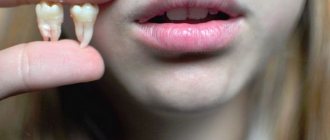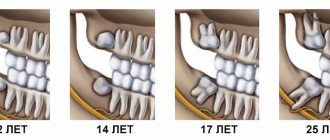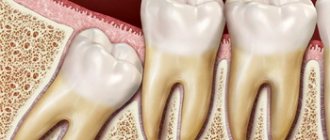Publication date: 10/10/2018
The growth of a wisdom tooth has its own peculiarities - by the time it begins to erupt, the dentition has already formed, and there is no room left for its normal development. Improper eruption is accompanied by inflammatory processes, since an infection can easily get into injured tissues.
As the process progresses deeper, periodontitis may develop. The inflammatory process is accompanied by redness and swelling of the gums, severe pain appears, and an unpleasant odor comes from the mouth. Wisdom loss can cause excruciating pain.
To eliminate toothache, you need to know the cause of its occurrence. This work can only be performed professionally by a specialist in a clinic setting. But before visiting the dentist, the condition can be alleviated a little. There are recipes that will help you independently eliminate inflammation and relieve pain, the source of which is a growing wisdom tooth.
“Eights” appear after 20 years. The pain of this process is due to two reasons:
- Wrong direction of growth;
- Inflammation of the gums due to problematic eruption.
The problem is also related to the fact that there was no milk tooth at the site of its growth, and there was no prepared socket. If the growth of a wisdom tooth is associated with prolonged pain, a visit to the doctor cannot be avoided.
Online consultation with a doctor
If you are worried about your wisdom teeth and have symptoms such as: pain in the “eights”, swelling of the gums around, swelling of the cheek. When chewing or while moving the jaw, smiling, talking, unpleasant sensations and pain appear. It is best to undergo an examination and consultation with a dentist. Because you won’t be able to cure a wisdom tooth on your own or help it erupt at home. And complications arising due to lost time can lead to the necessary more complex and expensive treatment:
- removing the “eight”;
- treatment of infected adjacent teeth;
- prosthetics;
- implantation.
Symptoms
If eruption proceeds without complications, then the person does not notice this process. But how do you understand that a wisdom tooth is growing? You may notice enlargement of the gums, feel swelling at the site of eruption and aching pain that is constantly present in the mouth. According to statistics, these teeth very rarely grow back without complications and problems. For most people, this process is painful and slow. To reduce the likelihood of illness, you should see a doctor and adjust the process if necessary.
Why do wisdom teeth hurt?
Cutting through “eights” without pain is a rare occurrence, so you need to know what to do in such cases.
There are several reasons for pain. The main ones are the following:
- The tooth grows sideways and is incorrectly positioned in relation to other teeth;
- There is no place for it to cut through;
- The tooth grows with caries;
- Poor quality treatment provided;
- The tooth has almost erupted, but is not yet completely visible, as it is covered by the mucous membrane; you should see a doctor to have the hood cut;
- Bacteria and pathogens can accumulate at the site where wisdom teeth erupt.
Rinsing with disinfectants will help. If the tooth grows normally, naturally, then it does not cause any particular trouble. Except for redness and swelling of the gums. Complications from the eruption of the figure eight, as a rule, arise due to a late visit to the dentist for help. If the pain increases and it is not possible to see a doctor, you have to take measures on your own. It should be borne in mind that all home remedies for wisdom tooth pain relief are temporary. You need to seek medical help at the first opportunity.
There are methods that can eliminate or dull pain at home. If the growing wisdom tooth is invisible and there is no discomfort, the ongoing process of eruption can be judged by the following signs:
- The gums and cheek are swollen;
- Body temperature increased slightly;
- Difficulties arise with facial expressions and chewing movements;
- The process of swallowing is associated with painful sensations.
If pain appears at the site where your wisdom tooth erupts, you should see a doctor. In cases where it is not possible to seek help from a dentist, you can use the following tips. There are five effective ways to relieve pain.
Why do difficulties arise during the eruption of wisdom teeth and what are they?
- There was no milk tooth at the site of its origin, so the gums are not prepared and an inflammatory process often occurs;
- Eruption occurs in adulthood;
- The jaw bones are fully formed, so it is difficult and painful to erupt;
- Tissue inflammation;
- Increased body temperature;
- The occurrence of pain in the ear and throat area.
This tooth does not erupt in one day, so unpleasant symptoms will accompany the person for quite a long time. If nothing is done, the situation can lead to serious consequences, for example, bone inflammation. If you experience any pain in the oral cavity, it is recommended to immediately visit a dentist. This approach will allow you to avoid serious consequences, and cure the disease at the initial stage.
Expert opinion
Emir Romanovich Omerelli
Maxillofacial surgeon, implantologist
Experience: more than 13 years
Whatever pain relief option you choose, it is important to remember that the absence of pain does not mean the absence of problems. The best option for a person with acute pain is to urgently come to the dental clinic. Moreover, acute pain is a reason for appointment out of turn and without an appointment. Timely correction of the situation - treatment or tooth extraction - will minimize the harm caused to the diseased organ of the oral cavity and the entire body as a whole.
Main types of mouth rinses
The procedure is mainly based on recipes from traditional medicine, which can be beneficial if used correctly. In certain cases, dentists themselves prescribe a number of solutions prepared at home. They can be auxiliary during the main medical therapy, as well as basic, when it is only necessary to support natural processes in the body.
Correct selection of the solution allows you to achieve the following results:
- Reducing the risk of infection, its spread, penetration into other tissues, into the blood;
- Removal of tumors, inflammation;
- Improving the regenerative or restorative abilities of periodontal tissues and gums;
- Reduced pain symptoms. Unpleasant sensations will not completely disappear, but they can be significantly hidden with local medications; if necessary, you can take special painkillers;
For these purposes, a variety of products can be used; their effectiveness will depend on their composition and active component. There are folk recipes that are accessible, as well as suspensions developed by specialists in the field of dentistry. They can be based on plant components, compounds that have more pronounced active properties. There are also differences in price, regarding contraindications and areas of use. Manufacturers often try to combine several quality features at once, so that when applied, the effect is complex.
When choosing what to rinse a wisdom tooth with, based on accessibility, safety, and effectiveness, the following folk recipes can be distinguished:
- Sage decoction . 2 cups boiling water, 3 tbsp. herbs, you can infuse for about an hour in a bath or boil for 5-7 minutes;
- Chamomile infusion . 0.5 liters of water, 100 grams of dry chamomile. The dry plant is poured with boiling water, infused, filtered;
- Oak bark . You can find ready-made products based on oak bark on sale. Prepare a similar remedy yourself using ½ liter of boiling water, 6 tbsp. raw materials, this whole mixture is brought to a boil again, cooled, and applied once every 1-2 hours. You can add a few tablespoons of sage to the liquid, be sure to strain;
- Soda . A teaspoon of baking soda and ½ cup of warm water are mixed and used for rinsing, although the use of this mixture is more like a lotion. Sometimes a few drops of iodine are added. The liquid stays on the problem area for about a minute, is spit out, sudden movements are not recommended.
- Propolis . The bee product solution is universal, including in dentistry. You need to dilute a few drops of tincture in warm water and rinse 4-5 times a day. The drug goes well with calendula decoction.
These are just some recipes for rinsing your teeth, including root wisdom. Some dentists approve of such methods, but there are individual cases that require special actions. It is important to use only warm solutions to avoid burns, hypothermia and the injured area. The liquid should be directed directly to the lesion, and not spread throughout the entire oral cavity; it is better to do this after eating.
If ready-made suspensions are used, it is important to follow the instructions and frequency of use. It would be useful to study the composition, by which you can understand the main effect. It is advisable to choose such drugs together with a specialist.
How to relieve the condition yourself
1. You can use pharmaceutical drugs that are available without a prescription:
- Remedies for eliminating inflammation: Ibuprofen and Paracetamol;
- Painkillers: Analgin;
- Gels for gum pain relief: Metrogyl-Denta and Xolisal;
- Antiseptics: Miramistin, Chlorhexidine;
- Maraslavin lotions will relieve swelling and eliminate pain.
2. Decoctions of medicinal herbs. Complications during the eruption of a wisdom tooth are associated with injury to the surrounding gum tissue. Without help, the consequences can be serious. If there is throbbing pain and swelling in the problem area, you should consult a doctor. The danger is that the accumulated pus can quickly spread from the soft tissue of the jaw. Frequent rinsing with a decoction of oak bark, brine, tincture of sage, calendula or chamomile is an effective remedy for relieving swelling and pain relief. You can use a decoction of chicory root.
3. If there is no pharmacy nearby, you can use salt water and soda. It is useful to drop iodine into the solution.
4. Bee products help with dental problems - propolis tincture will relieve swelling, soothe inflamed gum tissue and stop the development of infection.
5. A cold compress will temporarily soothe a sore tooth.
All of the above methods can be used temporarily until you can go to the doctor. It should be remembered that the sooner this meeting occurs, the lower the likelihood of complications.
Remember: it is forbidden to heat the sore spot, as the development of the inflammatory process will only accelerate.
Symptoms that many patients feel:
· Sore gums. This happens because the sharp edges of the coronal part press on the mucous membrane, causing irritation. If the tooth grows without complications, the pain will be dull and tolerable. But if the negative sensations are strong and constant, then we are talking about the development of an inflammatory process, and in this case it is necessary to urgently visit a doctor;
- Swelling and heaviness.
This is a complication in which the gum hangs over part of an already erupted tooth;
- Fever without signs of a cold
– this is a serious symptom that indicates that the process is complicated and the help of a doctor is needed;
- Heaviness in the chewing muscles
, which complicates the opening and closing of the oral cavity;
- Pain when swallowing indicates the development of a purulent abscess.
Pain due to pathogenic processes in the tooth
The wisdom tooth is the most remote and it is quite difficult to maintain proper hygiene, especially if the gums around it are bothering you. Therefore, it is not uncommon for caries, pulpitis or periodontitis to develop. Then the patient feels pain in the area of the wisdom tooth.
Sharp pain is characteristic of caries; it occurs when irritants, such as hot, sweet or sour foods, come into contact with the tooth. It subsides some time after the stimulus is removed.
If there is no influence of irritants, but acute pain periodically appears, this indicates the presence of symptoms of pulpitis. Periods of pain are longer than with caries and often appear at night.
Aching pain is a sign of periodontitis, accompanied by swelling of the gums or cheeks, intensified by pressure. Advanced periodontitis affects the deeper layers of bone tissue and causes the release of pus.
If you experience any unpleasant sensations, contact a specialist. Only professional diagnostics can identify the true cause and prevent the development of more serious diseases. This is especially true for the wisdom tooth, which is more susceptible to negative factors than all other teeth.
Negative consequences of late eruption of “eights”
The inconvenient location of these teeth for cleaning leads to the accumulation of bacteria and the development of caries, which spreads to neighboring teeth.
Late growth promotes the formation of tumors and cysts.
Maybe:
- Excessive tissue growth that will have to be removed surgically;
- Mechanical displacement of adjacent teeth in the process of freeing up space;
- Violation of the position of the jaws;
- Headache;
- Uneven distribution of load when chewing;
- Formation of traumatic nodes and gingival hood;
- Overhang of the mucous membrane, under which bacteria accumulate.
If measures are not taken in a timely manner, the pathological process will spread, affecting adjacent teeth, cheeks, tongue, chewing muscles, jaw bone and periodontium.
The best treatment is to see a doctor
If after all the manipulations the pain does not go away, but only intensifies, swelling appears and the temperature rises, you should immediately consult a doctor.
Sources:
- https://cyberleninka.ru/article/v/kompleksnoe-lechenie-hronicheskogo-retsidiviruyuschego-aftoznogo-stomatita-s-ispolzovaniem-preparatov-lineyki-asepta Balashova L.V., Barakov M.A., Khaikin M.B. The use of "Asept" in the treatment of periodontal tissue diseases, bulletin of the medical institute "REAVIZ"
- Report on clinical trials to determine/confirm the preventive properties of commercially produced personal oral hygiene products: mouth rinse "ASEPTA PARODONTAL" - Solution for irrigator." Doctor of Medical Sciences Professor, Honored Doctor of the Russian Federation, Head. Department of Preventive Dentistry S.B. Ulitovsky, doctor-researcher A.A. Leontiev First St. Petersburg State Medical University named after academician I.P. Pavlova, Department of Preventive Dentistry.
- Report on clinical trials of anti-inflammatory balm for gums "Asepta" adhesive, St. Petersburg State Medical University, 2007
Painkillers
In your home medicine cabinet you will probably find a remedy that will help relieve excruciating pain. But remember: any pill only temporarily relieves symptoms, but does not solve the problem as a whole. Therefore, you can’t put off going to the dentist!
General analgesics
It is recommended to take a tablet of Ketanov, Nurofen, Analgin, Etoricoxib or other analogues. The analgesic effect lasts from 1 to 5 hours. Sometimes the analgesic does not work. In this case, you cannot increase the dose of the drug; follow the instructions. Overdose causes poisoning and other serious complications.
Anti-inflammatory drugs
Ibuprofen, Paracetamol, Diclofenac and other anti-inflammatory drugs are also taken orally. They provide an analgesic effect and relieve fever, which often rises with problematic growth of the figure eight.
Topical ointments and gels
Gel Kamistad, Metrogyl Denta, Cholisal and the like give an analgesic, antibacterial and wound-healing effect. After application, the gums “freeze” for some time – 2-3 hours. Instead of ointment or gel, Angilex anesthetic spray is also used.
You can apply a piece of ice or something cold to the cheek where the tooth hurts. But do not overdo it - 5-7 minutes will be enough, otherwise severe hypothermia can lead to tissue necrosis.
Attention: do not take antibiotics without a doctor's prescription!
Surgical methods of treatment
In 90% of cases, problematic wisdom teeth are removed. The operation is planned only after X-ray diagnosis. The doctor must examine the condition of the tooth, the shape and position of the roots in the picture, and assess all the risks.
First, the gingival hood is excised using a surgical scalpel. Then the doctor cleans out the accumulated plaque and purulent exudate, and then washes the wound with an antiseptic. If the wisdom tooth is located vertically and occupies a normal position in the row, then there is no need to remove it.
In case of dystopia (position at an angle), removal is prescribed - the “figure eight” is pulled out with hand forceps. If the unerupted tooth lies horizontally, then it is sawed with a drill and taken out in parts, and the wound is sutured.
The operation lasts 10-40 minutes, depending on the task. The manipulations are carried out under local anesthesia, you will not feel pain.










